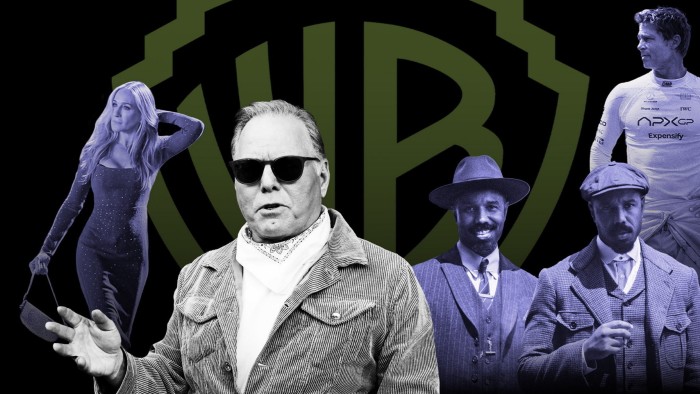Just three years ago, media chief David Zaslav pulled off the deal of his life: combining his much smaller television company Discovery with HBO-owner Warner Bros in a $43bn merger that he described as a “rendezvous with destiny”.
On Monday, Zaslav, in effect, unwound that deal by splitting Warner Bros Discovery into two companies facing very different futures.
Its streaming and studios business, housing HBO and Warner Bros’ production facilities, is primed for battle with US tech groups including Netflix. However, its still lucrative legacy networks business, which includes CNN, Discovery and the bulk of the group’s $37bn of debt, is facing the prospect of an irreversible decline in viewers.
Within Warner’s rank and file, there was a sense of exasperation at the news, with some complaining of having to go through years of upheaval only to find themselves back where they started.
The move “reveals a company fumbling its way through disruption”, said Emarketer analyst Paul Verna.
Bankers and industry executives say the break-up of WBD is another significant milestone in the disintegration of the swashbuckling cable era.
Cable television, one of the most lucrative businesses in media history, is a melting ice cube. The growth of Netflix and heavy investments in streaming from the likes of Apple and Amazon have prompted millions of Americans to ditch their cable television subscriptions.
The past decade has been characterised by painful lay-offs, restructurings and executive oustings as the industry grapples with its new circumstances.
Several advisers to top media executives offered a grim assessment of the WBD break-up, which follows a similar split at its rival Comcast.
One person described the plan as “one big, ugly exit tax” for shareholders hoping to move on from legacy media — and one that does little to address the broader structural challenges. Another simply said: “At the end of the day, nobody really wants these assets”.
What is clear is that Monday’s deal is another win for Zaslav, the native New Yorker who elbowed his way to the top of Hollywood three years ago with a debt-heavy merger.
Zaslav, who spent his career working in television, moved to Los Angeles in 2022. He set up shop at Jack Warner’s old desk, waxed poetic about the legacy of the Warner brothers and proceeded to make a series of unpopular decisions that led to him being labelled “the most hated man in Hollywood”.

During his time running the enlarged business, Zaslav laid off thousands of employees. The cable tycoon was adamant that audiences still wanted Discovery’s shows from channels such as HGTV and the Food Network, which he claimed would help HBO’s flagship streaming service Max catch up with Netflix.
He went on to change the name of HBO Max, which offers hit series including The Last of Us and The White Lotus, to Max, to try to broaden its appeal to a global audience. The name was then changed back to HBO Max.
In a memo to staff on Monday, Zaslav claimed the merger of Warner Bros and Discovery had worked, yet WBD shares have dropped from $24 to $9 since the deal was consummated in 2022.

Unlike his shareholders, Zaslav has made a handsome return. The chief executive has been showered with almost $400mn in pay and stock options in the past three years. His latest pay package of $52mn was rejected last week by shareholders in a nonbinding, largely symbolic protest vote.
Zaslav, who has recently been spotted courtside at New York Knicks games, will continue to preside over WBD’s faster-growing and more glamorous assets following the break-up.
Turning around WBD’s businesses in long-term decline — including CNN and TNT — will be a problem for former McKinsey consultant Gunnar Wiedenfels, WBD’s chief financial officer.
While some of WBD’s problems were inescapable, the company compounded them with several mis-steps, such as the decision to launch and then quickly abort a new CNN streaming service. The move has recently been revived under CNN chief Mark Thompson.
HBO Max has gradually been rolled out around the world. But after initially touting a strategy to broaden its scope to compete with Netflix, the WBD team reversed course, announcing that focusing on certain types of prestige content would now be key.
In his memo this week, Zaslav told WBD staff that “the world around us continues to evolve rapidly”, with technology, consumer behaviour and the media landscape “transforming how stories are created, distributed, and experienced”.
The WBD deal is the latest blockbuster US media merger to be shaken apart by the shifting tectonic plates underneath the industry. It began with the $350bn combination of AOL and Time Warner in 2000, leading to the $85bn acquisition of Time Warner by AT&T in 2018 and then the spin-off of Warner with Discovery in 2022.
With the media industry in disarray, the WBD break-up could trigger further deals, said executives and bankers.
WBD’s streaming business could be an attractive target for a tech giant or be merged with another studio. “Amazon, Apple, YouTube, or somebody else could come in now,” said a person who works closely with one of the big tech groups.
Veteran industry executive Jonathan Miller, who now runs investment firm Integrated Media, said the break-up of WBD would unlock several other potential deals, such as a potential tie-up between WBD’s networks division and Comcast’s new cable business, Versant.
He added that investors would also now start to look at the streaming and TV businesses of the remaining media conglomerates, Disney and Paramount.
These deals, however, would be about focus, Miller said, rather than trying to bulk up as before. “People are getting their house in order,” he added.
